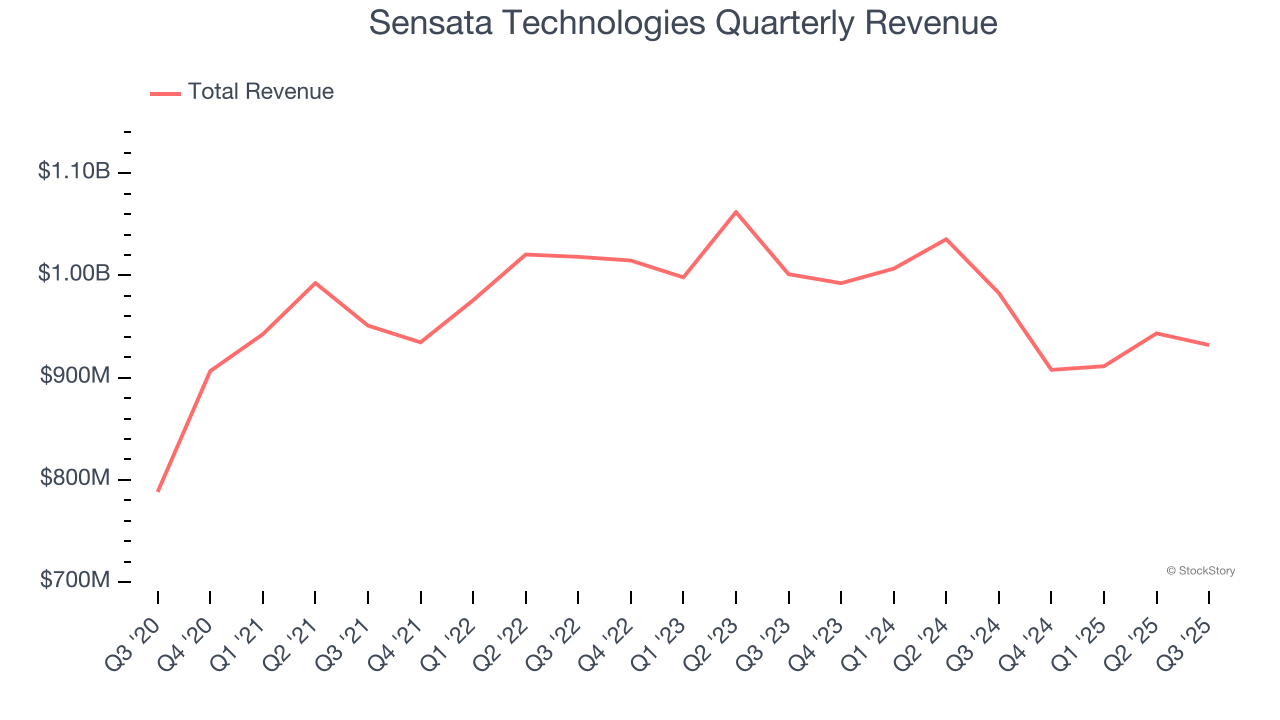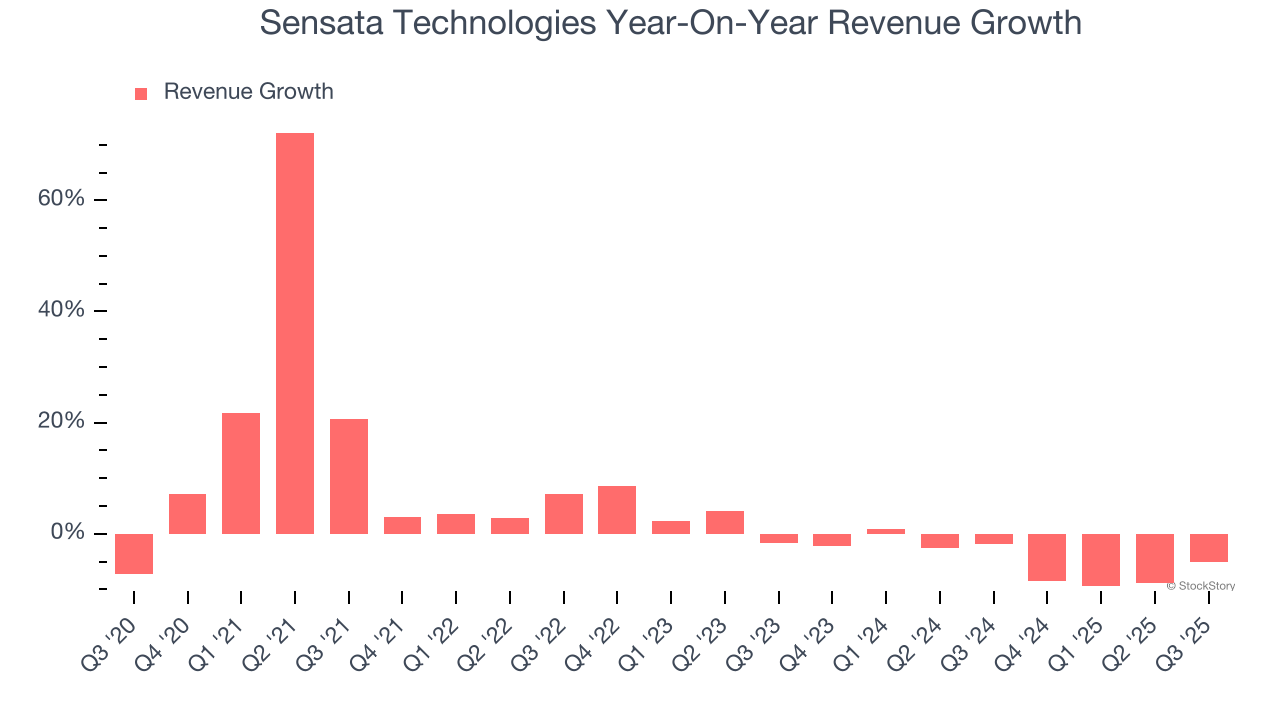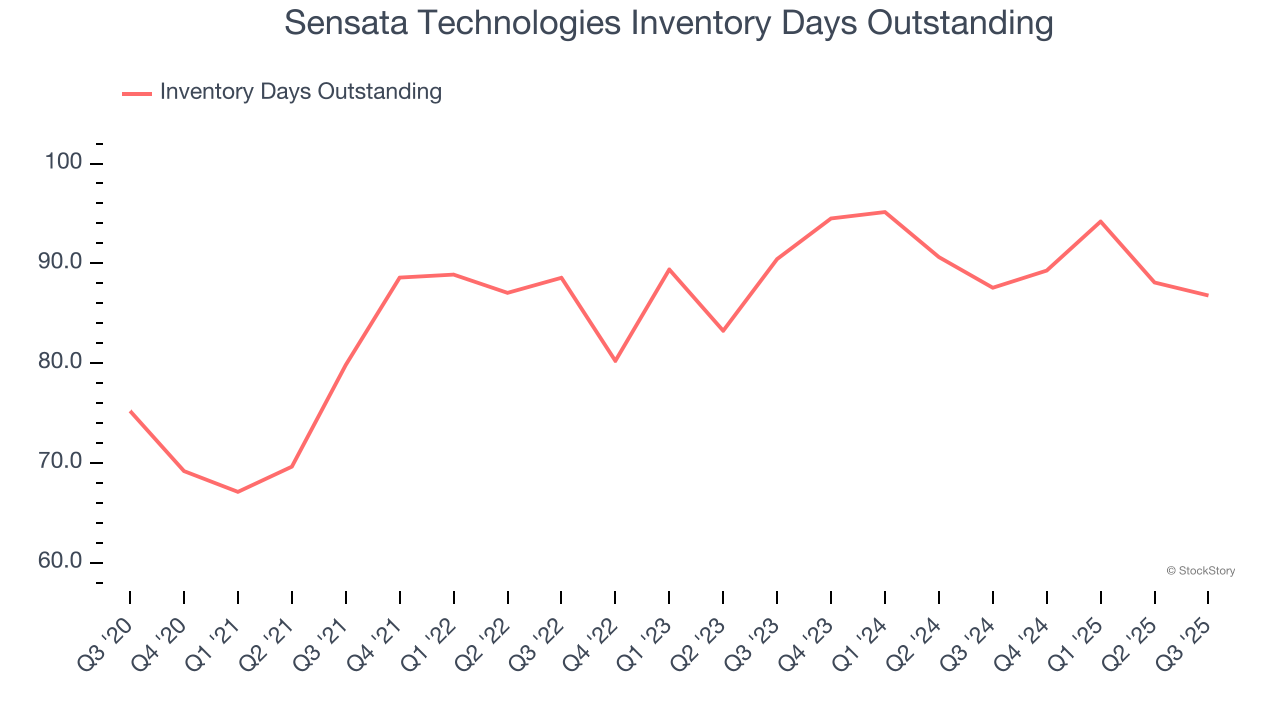
Sensor manufacturer Sensata Technology (NYSE:ST) reported revenue ahead of Wall Street’s expectations in Q3 CY2025, but sales fell by 5.2% year on year to $932 million. On the other hand, next quarter’s revenue guidance of $905 million was less impressive, coming in 1.4% below analysts’ estimates. Its non-GAAP profit of $0.89 per share was 4.6% above analysts’ consensus estimates.
Is now the time to buy Sensata Technologies? Find out by accessing our full research report, it’s free for active Edge members.
Sensata Technologies (ST) Q3 CY2025 Highlights:
- Revenue: $932 million vs analyst estimates of $922.1 million (5.2% year-on-year decline, 1.1% beat)
- Adjusted EPS: $0.89 vs analyst estimates of $0.85 (4.6% beat)
- Adjusted EBITDA: $212.1 million vs analyst estimates of $210.1 million (22.8% margin, 1% beat)
- Revenue Guidance for Q4 CY2025 is $905 million at the midpoint, below analyst estimates of $917.7 million
- Adjusted EPS guidance for Q4 CY2025 is $0.85 at the midpoint, below analyst estimates of $0.86
- Operating Margin: -13.2%, up from -20.3% in the same quarter last year
- Free Cash Flow Margin: 14.6%, up from 9.3% in the same quarter last year
- Inventory Days Outstanding: 87, down from 88 in the previous quarter
- Market Capitalization: $4.6 billion
“Our focused execution against the key pillars of our transformation drove exceptionally strong results in the third quarter, with all key metrics exceeding our expectations. In addition to delivering today, we are laying the foundation to drive long-term shareholder value by continuing to improve financial performance while further strengthening our balance sheet with improved cash generation and disciplined deleveraging," said Stephan von Schuckmann, Chief Executive Officer of Sensata.
Company Overview
Originally a temperature sensor control maker and a subsidiary of Texas Instruments for 60 years, Sensata Technology Holdings (NYSE: ST) is a leading supplier of analog sensors used in industrial and transportation applications, best known for its dominant position in the tire pressure monitoring systems in cars.
Revenue Growth
Examining a company’s long-term performance can provide clues about its quality. Any business can experience short-term success, but top-performing ones enjoy sustained growth for years. Over the last five years, Sensata Technologies grew its sales at a mediocre 4.4% compounded annual growth rate. This was below our standard for the semiconductor sector and is a tough starting point for our analysis. Semiconductors are a cyclical industry, and long-term investors should be prepared for periods of high growth followed by periods of revenue contractions.

We at StockStory place the most emphasis on long-term growth, but within semiconductors, a half-decade historical view may miss new demand cycles or industry trends like AI. Sensata Technologies’s performance shows it grew in the past but relinquished its gains over the last two years, as its revenue fell by 4.8% annually. 
This quarter, Sensata Technologies’s revenue fell by 5.2% year on year to $932 million but beat Wall Street’s estimates by 1.1%. Despite the beat, the drop in sales could mean that the current downcycle is deepening. Company management is currently guiding for flat sales next quarter.
Looking further ahead, sell-side analysts expect revenue to grow 2.6% over the next 12 months. While this projection suggests its newer products and services will catalyze better top-line performance, it is still below the sector average.
Unless you’ve been living under a rock, it should be obvious by now that generative AI is going to have a huge impact on how large corporations do business. While Nvidia and AMD are trading close to all-time highs, we prefer a lesser-known (but still profitable) stock benefiting from the rise of AI. Click here to access our free report one of our favorites growth stories.
Product Demand & Outstanding Inventory
Days Inventory Outstanding (DIO) is an important metric for chipmakers, as it reflects a business’ capital intensity and the cyclical nature of semiconductor supply and demand. In a tight supply environment, inventories tend to be stable, allowing chipmakers to exert pricing power. Steadily increasing DIO can be a warning sign that demand is weak, and if inventories continue to rise, the company may have to downsize production.
This quarter, Sensata Technologies’s DIO came in at 87, which is 1 more days than its five-year average. These numbers suggest that despite the recent decrease, the company’s inventory levels are slightly above the long-term average.

Key Takeaways from Sensata Technologies’s Q3 Results
It was good to see Sensata Technologies beat analysts’ EPS expectations this quarter. We were also happy its adjusted operating income outperformed Wall Street’s estimates. On the other hand, its revenue guidance for next quarter slightly missed. Overall, this quarter was mixed. The stock remained flat at $30.85 immediately following the results.
Is Sensata Technologies an attractive investment opportunity at the current price? The latest quarter does matter, but not nearly as much as longer-term fundamentals and valuation, when deciding if the stock is a buy. We cover that in our actionable full research report which you can read here, it’s free for active Edge members.
